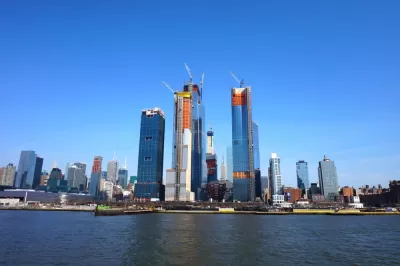The developers of Hudson Yards received $1.2 billion in financing from the EB-5 program, all made possible by a map that gerrymandered the project into the same neighborhood as Harlem public housing.

Kriston Capps reports on the financial deal that helped finance the Hudson Yards mega-project in New York City. Bolstering a point that heavily criticized design choices are not the component of the project most deserving our contempt. Capps explains that reasoning:
Without their knowledge, the residents of a number of public housing developments helped to make Hudson Yards possible. The mega-luxury of this mini-Dubai was financed in part through a program that was supposed to help alleviate urban poverty. Hudson Yards ate Harlem’s lunch."
Specifically, the project raised at least $1.2 billion of its financing through a controversial investor visa program known as EB-5. This program enables immigrants to secure visas in exchange for real estate investments. Foreigners who pump between $500,000 and $1 million into U.S. real estate projects can purchase visas for their families, making it a favorite for wealthy families abroad, namely in China. EB-5 is supposed to be a way to jumpstart investment in remote rural areas, or distressed urban ones.
Related Companies, the developer of Hudson Yards, "raked in" at least $1.2 billion in EB-5 funds for the project, despite the project being "nobody's idea of distressed."
So how did Related Companies manage to qualify for the project? A highly gerrymandered map, created by Empire State Development, the economic development agency for the state of New York.
New York state “gerrymandered” a map to qualify Hudson Yards for $1.6 billion in financing meant for low-income areas—by threading it to public housing in Harlem. @kristoncapps reports:https://t.co/71yXG5KqIl pic.twitter.com/gX3PrCHlex
— CityLab (@CityLab) April 21, 2019
As note by Capps, the Hudson Yards project is one symptom of larger problems with the EB-5 program, and not just an example of systematic failures of New York real estate.
Sophie Kasakove provides additional follow-up coverage of Capps's reporting, tying the EB-5 story of Hudson Yards to controversies created by the use of tax increment financing in Chicago.
FULL STORY: The Hidden Horror of Hudson Yards Is How It Was Financed

Alabama: Trump Terminates Settlements for Black Communities Harmed By Raw Sewage
Trump deemed the landmark civil rights agreement “illegal DEI and environmental justice policy.”

Planetizen Federal Action Tracker
A weekly monitor of how Trump’s orders and actions are impacting planners and planning in America.

The 120 Year Old Tiny Home Villages That Sheltered San Francisco’s Earthquake Refugees
More than a century ago, San Francisco mobilized to house thousands of residents displaced by the 1906 earthquake. Could their strategy offer a model for the present?

In Both Crashes and Crime, Public Transportation is Far Safer than Driving
Contrary to popular assumptions, public transportation has far lower crash and crime rates than automobile travel. For safer communities, improve and encourage transit travel.

Report: Zoning Reforms Should Complement Nashville’s Ambitious Transit Plan
Without reform, restrictive zoning codes will limit the impact of the city’s planned transit expansion and could exclude some of the residents who depend on transit the most.

Judge Orders Release of Frozen IRA, IIJA Funding
The decision is a victory for environmental groups who charged that freezing funds for critical infrastructure and disaster response programs caused “real and irreparable harm” to communities.
Urban Design for Planners 1: Software Tools
This six-course series explores essential urban design concepts using open source software and equips planners with the tools they need to participate fully in the urban design process.
Planning for Universal Design
Learn the tools for implementing Universal Design in planning regulations.
Clanton & Associates, Inc.
Jessamine County Fiscal Court
Institute for Housing and Urban Development Studies (IHS)
City of Grandview
Harvard GSD Executive Education
Toledo-Lucas County Plan Commissions
Salt Lake City
NYU Wagner Graduate School of Public Service





























